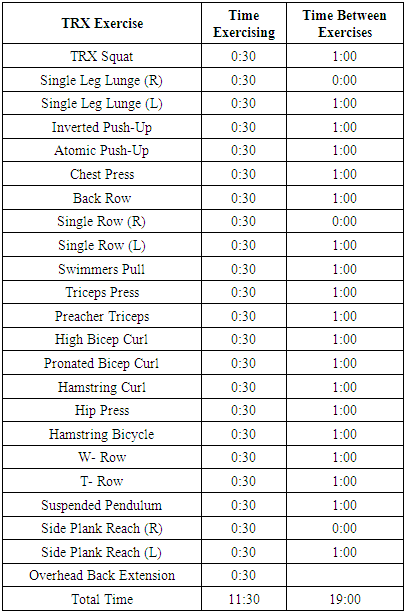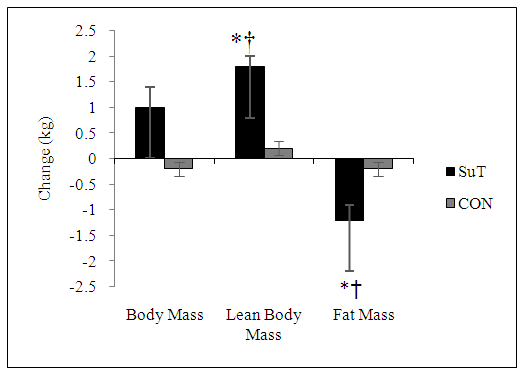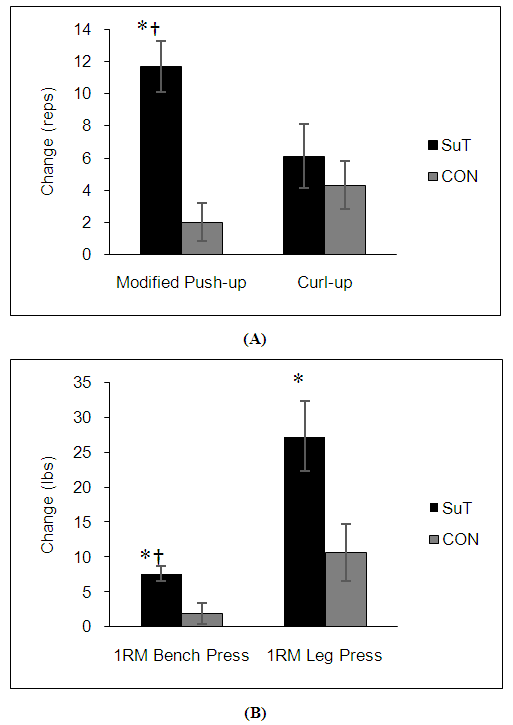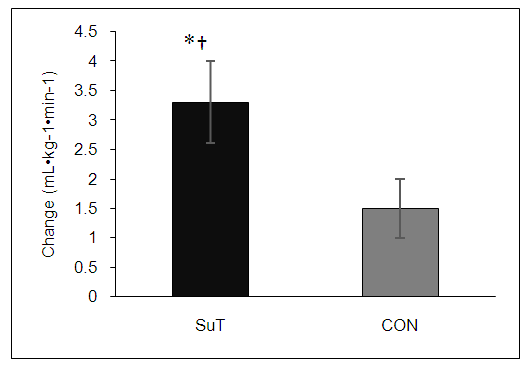-
Paper Information
- Paper Submission
-
Journal Information
- About This Journal
- Editorial Board
- Current Issue
- Archive
- Author Guidelines
- Contact Us
International Journal of Sports Science
p-ISSN: 2169-8759 e-ISSN: 2169-8791
2019; 9(2): 28-34
doi:10.5923/j.sports.20190902.02

Suspension Training Improved Muscular Endurance, Cardiovascular Fitness, and Body Composition in College-Aged Women
Wesley D. Dudgeon1, Elizabeth P. Kelley1, Timothy P. Scheett1, Michael G. Flynn1, 2
1Department of Health and Human Performance, College of Charleston, Charleston, SC, USA
2HCA South Atlantic, Charleston, SC, USA
Correspondence to: Wesley D. Dudgeon, Department of Health and Human Performance, College of Charleston, Charleston, SC, USA.
| Email: |  |
Copyright © 2019 The Author(s). Published by Scientific & Academic Publishing.
This work is licensed under the Creative Commons Attribution International License (CC BY).
http://creativecommons.org/licenses/by/4.0/

Suspension training (SuT) is a relatively newly popularized mode of exercise that allows individuals to use their body weight for resistance and is typically performed in an interval fashion. Over a period of six weeks 20 women (21.0 ± 0.3 yrs) completed 18 60-minute SuT workouts. Control (n=13) subjects maintained normal activity. All subjects underwent pre and post testing of muscular fitness, cardiovascular fitness, body composition and flexibility. There were significant (p<0.001) improvements in upper-body muscular endurance (push-ups in 60 seconds; 37.7% increase), upper-body strength via 3-RM bench press (24.4% increase), cardiovascular fitness (8.4% increase), and lean body mass (2.0±0.2 kg gain); as well as a decrease (p<0.001) in fat mass (1.4±0.3 kg). The SuT also saw significant increases in 3-RM (leg press), repetitions to fatigue (70% of 1-RM leg press) and flexibility (sit and reach test) after SuT. There were no observed changes in the control group. These data suggest that in college-aged females, a short-term SuT program performed in a group setting can elicit beneficial changes in all aspects of physical fitness. SuT may offer advantages over single mode training, as it appeared to improve all five components of fitness.
Keywords: Exercise, Interval training, Strength, Flexibility, VO2max
Cite this paper: Wesley D. Dudgeon, Elizabeth P. Kelley, Timothy P. Scheett, Michael G. Flynn, Suspension Training Improved Muscular Endurance, Cardiovascular Fitness, and Body Composition in College-Aged Women, International Journal of Sports Science, Vol. 9 No. 2, 2019, pp. 28-34. doi: 10.5923/j.sports.20190902.02.
Article Outline
1. Introduction
- Suspension training (SuT) is a novel form of unstable (i.e. labile environment) training that has recently grown in popularity, likely due to the fact that SuT equipment can be easily transported and utilized in a variety of locations (e.g. home, fitness facility, outdoors, hotel room, etc.). SuT is a unique form of instability resistance training that allows users to perform exercises targeting both major and minor muscle groups in every plane of motion while achieving a whole body resistance workout and a stimulus sufficient to elicit cardiovascular adaptations [1]. SuT requires users to recruit and contract their core musculature and peripheral stabilizer muscles to maintain proper body position and technique (stability) while the prime movers are recruited to perform a variety of resistance exercise movements [2]. Fenwick, Brown, & McGill [3] reported that suspension exercises caused similar prime muscle activation as traditional “fixed” resistance exercises, and SuT also requires activation of multiple core muscles for maintaining balance and stability [2, 4-6]. There has been an increase in published research on instability training, including SuT, in the last several years, however the overall volume of literature is still low. Researchers reported that instability training was effective for increased muscle activation using lower force generating exercises as well as for improved static and dynamic balance, proprioception, and spinal stability [2, 4, 6-11]. Additionally, individuals undergoing physical rehabilitation as well as those who are interested in training for improved physical fitness, including activities of daily living, often need to use lower force generating exercises (i.e. non-ground-based free weight exercises). Incorporation of instability training exercises can still provide many benefits typically associated with ground-based free weight exercises [5, 12]. Despite the fact that traditional resistance training (i.e. free-weights and machine weights) can provide numerous health-related benefits, many females tend to avoid resistance training for personal reasons or anecdotal misconceptions (e.g. safety, fear, intimidation, inexperience, uncertainty) [13]. Instability training has been shown to be as effective as traditional resistance training at improving muscular fitness [8, 9, 14], however SuT has the potential to provide many more positive fitness changes. No training studies exist detailing the effects of an SuT program on variables such as body composition, flexibility and cardiovascular fitness [1]. Thus, the purpose of this study was to determine the effectiveness of a six-week suspension-training program on measures of muscular strength, muscular endurance, cardiorespiratory fitness, flexibility and body composition in untrained college-age women.
2. Methods
2.1. Subjects
- Thirty-three untrained college-aged females who were not currently engaging in regular, structured exercise (aerobic, resistance, yoga, dance, fitness class, etc.) were recruited for study participation. Testing and experimental protocol were explained to subjects, and all subjects signed the Informed Consent form during the initial visit to the Human Performance Lab. All subjects completed the Physical Activity Readiness Questionnaire (PAR-Q) and confidential health questionnaires regarding current health status, menstrual status, and physical activity habits in order to ensure that there were no contraindications to participation in the SuT program and to verify they were not involved in a regular, structured exercise program. Each subject was then instructed to continue using her birth control medication or other prescription medication as prescribed by her physician throughout the training and testing periods. After being cleared for study participation, a random number table was used to place subjects in either the suspension training (SuT) group or the control (CON) group. The SuT group (n=20) participated in 6 weeks (18 sessions) of a SuT protocol, and the CON group (n=13) was instructed to continue their normal daily routine. The College of Charleston Institutional Review Board approved all procedures used in this study.
2.2. Procedures
- All subjects completed the same battery of performance tests during the week prior to and following the training period. Testing days began with anthropometric measures (i.e. height, body mass and body composition), which were assessed using a standard medical stadiometer, digital media scale, and hydrostatic weighing, respectively. Subjects then completed the five-minute Forestry Step Test [15] for cardiovascular fitness assessment. Heart rates were recorded using a Polar Heart Rate Monitor (Polar Electro, USA). Individual subject data, including heart rate, age, and body weight were used to estimate VO2max. Muscular fitness was assessed via tests of muscular strength (estimated 1RM tests for bench press and leg press) and muscular endurance (one-minute maximal push-up and curl-up tests, and repetitions at 70% of 1RM). This population was unfamiliar with heavy resistance training, thus a 3RM was used instead of the standard 1RM on bench press and leg press. The estimated 1RM was calculated from the 3RM test using a standard conversion formula [16]. After evaluating muscular strength, subjects performed as many modified push-ups and curl-ups as possible in one minute, while maintaining proper form and technique for each test. Muscular endurance was also assessed with maximal repetitions to fatigue at 70% of their estimated 1RM leg press and bench press.Trunk and hamstring flexibility was assessed using the sit and reach test. Each subject sat on the floor with shoes removed and placed their feet against the sit and reach box which was secured against a wall. Subjects then placed one hand on top of the other and, in a slow and controlled fashion, leaned forward as far as possible and held this position for two seconds. The furthest distance reached of three trials was used. Subjects were given ample time to rest between tests and total testing time was less than 90 minutes. All pre-testing and post-testing was done in the same order, used the same protocols, and were performed on the same equipment at the College of Charleston Human Performance Laboratory.
2.3. Exercise Training
- Each subject completed a familiarization session at least 24 hours prior to the pre-training testing session. During the familiarization session, each subject was shown how to perform each exercise to be used during the training intervention. All suspension training was performed using the TRX Home Trainer®.
|
2.4. Statistical Analyses
- All data were normally distributed and were analyzed using SigmaSat v3.5 (Point Richmond, CA). Dependent measures t-tests were used to evaluate changes within treatment groups and independent measures t-tests were used to compare differences between groups. A Bonferroni correction was used to control for multiple comparisons, thus the resulting significant level was adjusted to p<0.0167. All data are presented as mean ± standard error (SE).
3. Results
- There were no differences between the SuT (n=20) and CON (n=13) groups at baseline (Table 2).
|
3.1. Body Composition
- Following the study, neither group exhibited a significant change in total body mass. The SuT group (n=20) had a significant 1.5 ± 0.3 kg decrease in total fat mass (13.8 ± 1.4 to 12.4 ± 1.3 kg; p<0.001) and percent body fat (20.6 ± 1.4% to 18.2 ± 1.4%; p<0.001) along with a mean 2.0 ± 0.2 kg increase in lean body mass (50.6 ± 1.3 to 52.6 ± 1.2 kg; p<0.001) (Figure 1). There were no changes in any measured body composition variables in the CON group (n=13) following the intervention.
3.2. Muscular Fitness
- Upper body muscular fitness increased in the SuT group for bench press 3RM, estimated 1RM, and the number of push-ups completed in 60 seconds. No CON group measures were different from SuT group measures at the baseline time point. The SuT group (n=20) increased 3RM bench press (p<0.001) by 24.4% (71.0 3.2 to 88.3 2.9 lbs); as expected, the estimated 1RM also improved (p<0.001). There was a 37.7% increase (p<0.001) in push-ups completed from pre (28.4 3.1 reps) to post (39.1 ± 2.5 reps) in the SuT group, while no changes were observed in the CON group. The number of curl-ups completed in 60 seconds increased by 13.8% in the SuT group (39.1 3.2 to 44.5 3.2 reps), however results were non-significant (p=0.046) after adjusting the significance level. There were no changes in 3RM, estimated 1RM (Figure 2-B) or number of curl-ups completed in 60 seconds (Figure 2-A) in the CON group.
3.3. Cardiorespiratory Fitness
- Cardiorespiratory fitness, as assessed by estimated VO2max, also showed a significant (p<0.001) 8.4% improvement following the SuT intervention. Estimated VO2max increased from 39.1 1.5 ml•kg-1•min-1 to 42.4 1.6 ml•kg-1•min-1. The CON group had no changes from a baseline average of 40.0 1.5 ml•kg-1•min-1 which was no different from the baseline value for the SuT group (Figure 3).
3.4. Flexibility
- Sit-and-reach scores in the SuT group improved by 5.5% (p<0.001), while no changes were observed in the CON group. There were no differences in sit-and-reach scores between SuT (54.9 1.6cm) and CON group (58.4 2.2 cm) at baseline (Figure 4).
4. Discussion
- The SAID principle (specific adaptations to imposed demands) posits that endurance training does not induce increases in muscular strength or flexibility. Nevertheless, it is clearly understood that crossover benefits exist from high-intensity training or circuit training using body weight exercises and that there are clear benefits to employing hybrid exercise programs [17, 18]. We endeavoured to determine whether SuT would impact all five components of physical fitness (muscular strength and endurance, cardiovascular fitness, body composition, flexibility). Multiple exercise modalities are typically incorporated to address these five components, which necessitates more time and more equipment. Thus, the purpose of this study was to examine the effects of a 6-week suspension training program on physical fitness in untrained collegiate women. Anthropometric data, as well as body composition, muscular strength, muscular endurance, flexibility, and cardiorespiratory fitness variables were measured before and after the intervention period for both the treatment (SuT) and control (CON) groups.
4.1. Body Composition
- It is well documented that prolonged resistance training exercise programs (10-24 weeks) in resistance training-naïve young women generally elicit beneficial changes in body composition. For example, 14 weeks of thrice-weekly resistance training sessions in young women (28 6.2 years) resulted in a 15% drop in body fat percentage [19]. The decline in body fat reported by Prabahakaran et al. [19] was nearly twice what we observed (15% vs. 8.5%) but the intervention period was nearly twice as long. In the current study, we found a 3.1% increase in lean body mass, which is similar to the 3.3% increase in fat free mass seen following 24 weeks of thrice-weekly resistance training [20]. Increasing the exercise load to 1.5 hours per day, 5 days per week for 14 weeks did not result in substantial differences in body composition in 31 young women (28 4 years), with a 4.2% loss in body fat and 1.7% increase in lean body mass [21]; however, extending the study to 24 weeks produced a 9.7% drop in body fat and a 2.2% increase in lean body mass. The findings of Nindl et al. [21] were similar to the results of the current study, yet their study duration was three times as long and the exercise sessions were more than 30% longer. Performing multiple sets per exercise seems to be more beneficial than single sets. For example, a 14-week study employed three days per week of single sets and resulted in a 7% loss of body fat with no change in lean mass in untrained young women [22]. Conversely, four days per week of multiple sets resulted in a 15% loss of fat mass and a 4.9% increase in fat free mass [22]. Taken together, it appears that suspension training elicited changes in body composition similar to that of traditional resistance training, though the changes associated with SuT were realized with a lower exercise load. A more appropriate comparison with SuT may be programs that utilized both resistance and aerobic training, since our earlier work [1] showed that suspension training provides a moderate-intensity aerobic stimulus. Poehlman et al. [20] did not report beneficial changes in body composition following 17 weeks of aerobic training and seven weeks of resistance training, however this is not the typical finding in most published work. LeMura et al. [23] showed a 0% drop in body fat percentage and a 3% gain in fat free mass following 16 weeks of training that included two days/wk of aerobic exercise and one day/wk of resistance exercise. Though the literature on body composition changes associated with combined training is limited, our SuT group demonstrated body composition changes on par with those of combined programs.
4.2. Muscular Fitness
- The primary outcome variable for most resistance training studies is muscular strength, and to a lesser extent muscular endurance. Resistance training programs typically result in increases in muscular strength, usually assessed by 1RM. Poehlman et al. [20] reported that 24 weeks of thrice-weekly resistance training sessions produced a 39% increase in bench press and a 29% increase in leg press in young women (28 3 years). Sixteen weeks of thrice-weekly training sessions in a younger group of women (20 1 years) showed a 29% improvement in upper body press and 29% improvement in lower body press while only 8 weeks of training resulted in gains of 17% and 20% respectively. A group of cross-trained women (20.4 1 years) in the same study showed 12% and 18% gains in upper and lower body strength at eight weeks and 19% and 25% increases at 16 weeks [23]. Similarly, three 45-minute resistance-training sessions per week for 14 weeks resulted in a 27% overall increase in eight resistance exercises in younger (28 6.2 years) women [19]. In the current study, we found similar improvements to the referenced work, 21.8% in upper body and 23.2% in lower body 1 RM, with a substantially shorter training time.
4.3. Cardiorespiratory Fitness
- Cardiorespiratory fitness is not typically measured in resistance training interventions, as the primary focus is generally muscular fitness and body composition. However, aerobic exercise interventions and combined interventions (resistance training and aerobic training) often present cardiovascular fitness data as a primary outcome. Twenty-four weeks of aerobic exercise training (17 weeks of endurance exercise followed by seven weeks of interval training) in 13 young females (28 4 years) produced an 18% improvement in VO2max [20]. In the same study, three days per week of resistance training showed no change in VO2max in 16 young (28 4 years) females. Similarly, 16 weeks of thrice-weekly aerobic training sessions in a group of 10 young (20 2 years) females showed a 25% increase in VO2max, while the resistance-training group of 11 females showed no improvement in VO2max [23]. However, when combining resistance (1 day/wk) and aerobic (2 d/wk) exercise, LeMura et al. [23] failed to show any increase in VO2max. These studies show that aerobic exercise interventions produce a greater increase in VO2max than our 8.4% improvement; however, these comparative studies were two to three times the duration of our intervention. Further, while the resistance training-only studies showed no VO2max improvements, SuT significantly increased muscular fitness while also significantly improving cardiorespiratory fitness.
4.4. Flexibility
- Flexibility is not commonly an outcome variable in many exercise intervention studies. Some researchers measured flexibility following resistance-training interventions, and have found the improvements were intensity dependent [24]. Not surprisingly, exercise interventions such as yoga and pilates produce profound increases in flexibility [25-27]. What is unique about our findings is that SuT training does not specifically address flexibility, yet we found a 5.1% increase in back/hamstring flexibility along with the previously noted improvements in muscular fitness, cardiorespiratory fitness, and body composition.
4.5. Study Limitations
- While this study demonstrates that many aspects of physical fitness can be addressed with suspension training, there are study limitations to be noted. This was a homogenous sample (untrained, college-aged females), so caution should be made when extrapolating these results to populations of other ages, genders, and fitness levels. Next, this study did not assess leisure time physical activity, other than pre- and post-test questionnaire, thus the influence of physical work outside of the study cannot be discounted. Finally, all training sessions were performed with a maximum of 3 subjects to 1 research team member. This environment may be more conducive to positive outcomes than one could expect when training without supervision.
5. Conclusions
- It is clearly established that aerobic exercise training will stimulate adaptations resulting in improvements in cardiorespiratory fitness, while resistance training elicits improvements in muscular fitness (strength and/or endurance), and both modes of exercise typically cause beneficial changes in body composition (though the extent depends on the mode/duration/intensity/frequency of training). Hybrid exercise programs, combining aerobic and resistance exercise, high intensity exercise or circuit training have been shown to induce both cardiovascular and muscular fitness improvements, while also providing a time-efficient option compared to traditional single modality training. We found that short-term suspension training stimulated adaptations in college-aged females, making SuT a beneficial tool for addressing all five components of fitness in three hours per week. More work is needed to determine the extent of improvements with longer duration training and it is yet to be determined how athletic populations will respond to suspension training.
Disclosure
- Partial funding for this project was provided by Fitness Anywhere, INC. (San Francisco, CA)
 Abstract
Abstract Reference
Reference Full-Text PDF
Full-Text PDF Full-text HTML
Full-text HTML




